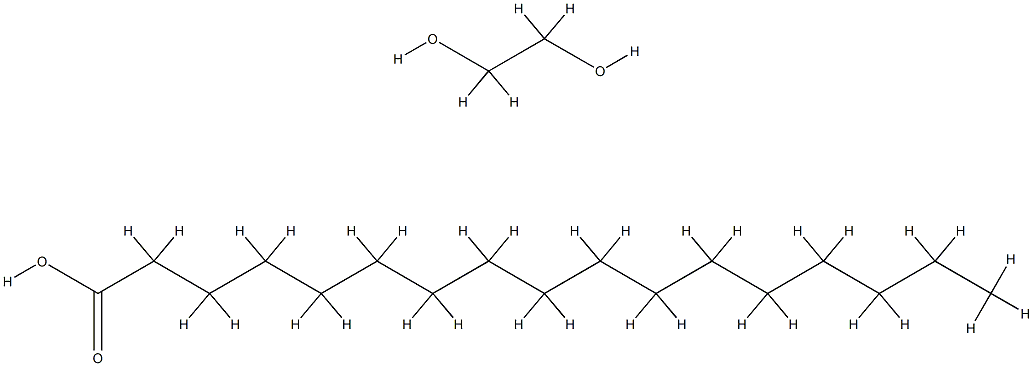폴리에틸렌 글리콜 디스테아린산
|
|
폴리에틸렌 글리콜 디스테아린산 속성
- 녹는점
- 35-37 °C
- 인화점
- >230 °F
- 냄새
- 100.00?%. 약한 밀랍 같은
- Dielectric constant
- 2.3(0.0℃)
- LogP
- 5.997 (est)
- CAS 데이터베이스
- 9005-08-7
안전
- 위험 및 안전 성명
- 위험 및 사전주의 사항 (GHS)
| WGK 독일 | 1 | ||
|---|---|---|---|
| RTECS 번호 | TQ4375000 | ||
| 기존화학 물질 | KE-27621 |
| 그림문자(GHS): | |||||||||||||||||||||||
|---|---|---|---|---|---|---|---|---|---|---|---|---|---|---|---|---|---|---|---|---|---|---|---|
| 신호 어: | Warning | ||||||||||||||||||||||
| 유해·위험 문구: |
|
||||||||||||||||||||||
| 예방조치문구: |
|
폴리에틸렌 글리콜 디스테아린산 C화학적 특성, 용도, 생산
화학적 성질
A soft, off-white solid. PH of 10% dispersion 7.26, saponification number variable. Soluble in chlorinated solvents, light esters, and acetone; slightly soluble in alcohols, insoluble in glycols, hydrocarbons, and vegetable oils. Combustible.용도
POLY(ETHYLENE GLYCOL) (N) DISTEARATE is used as an emulsifier for personal care and water treatment and as a processing aid in textile industry.정의
Distearate ester of polyglycol.생산 방법
Polyethylene glycol distearate is prepared by the direct reaction of fatty acids, particularly stearic acid, with ethylene oxide.Pharmaceutical Applications
Polyethylene glycol distearate is generally used as emulsifiers in oil-inwater- type creams and lotions. Its hydrophilicity or lipophilicity depends on the number of ethylene oxide units present: the larger the number, the greater the hydrophilic properties. Polyoxyl 40 stearate has been used as an emulsifying agent in intravenous infusions.Polyoxyethylene stearates are particularly useful as emulsifying agents when astringent salts or other strong electrolytes are present. It can also be blended with other surfactants to obtain any hydrophilic–lipophilic balance for lotions or ointment formulations.
Safety Profile
Poison by intravenous route. When heated to decomposition it emits acrid smoke and irritating fumes. See also POLYETHYLENE GLYCOL.Safety
Although Polyethylene glycol distearate is primarily used as emulsifying agents in topical pharmaceutical formulations, certain materials, particularly polyoxyl 40 stearate, have also been used in intravenous injections and oral preparations.Polyethylene glycol distearate has been tested extensively for toxicity in animals(8–13) and are widely used in pharmaceutical formulations and cosmetics. It is generally regarded as essentially nontoxic and nonirritant materials.
Polyoxyl 8 stearate
(hamster, oral): 27 g/kg
(rat, oral): 64 g/kg
Polyoxyl 20 stearate
(mouse, IP): 0.2 g/kg
(mouse, IV): 0.87 g/kg
저장
Polyoxyethylene stearates are generally stable in the presence of electrolytes and weak acids or bases. Strong acids and bases can cause gradual hydrolysis and saponification.The bulk material should be stored in a well-closed container, in a dry place, at room temperature.
비 호환성
Polyethylene glycol distearate is unstable in hot alkaline solutions owing to hydrolysis, and will also saponify with strong acids or bases. Discoloration or precipitation can occur with salicylates, phenolic substances, iodine salts, and salts of bismuth, silver, and tannins.Complex formation with preservatives may also occur.The antimicrobial activity of some materials such as bacitracin, chloramphenicol, phenoxymethylpenicillin, sodium penicillin, and tetracycline may be reduced in the presence of polyoxyethylene stearate concentrations greater than 5% w/w.Regulatory Status
Included in the FDA Inactive Ingredients Database (dental solutions; IV injections; ophthalmic preparations; oral capsules and tablets; otic suspensions; topical creams, emulsions, lotions, ointments, and solutions; and vaginal preparations). Included in nonparenteral medicines licensed in the UK. Included in the Canadian List of Acceptable Non-medicinal Ingredients.폴리에틸렌 글리콜 디스테아린산 준비 용품 및 원자재
원자재
준비 용품
폴리에틸렌 글리콜 디스테아린산 공급 업체
글로벌( 89)공급 업체
| 공급자 | 전화 | 이메일 | 국가 | 제품 수 | 이점 |
|---|---|---|---|---|---|
| Hebei Mojin Biotechnology Co., Ltd | +8613288715578 |
sales@hbmojin.com | China | 12453 | 58 |
| Henan Bao Enluo International TradeCo.,LTD | +86-17331933971 +86-17331933971 |
deasea125996@gmail.com | China | 2503 | 58 |
| Henan Tianfu Chemical Co.,Ltd. | +86-0371-55170693 +86-19937530512 |
info@tianfuchem.com | China | 21695 | 55 |
| Hefei TNJ Chemical Industry Co.,Ltd. | +86-0551-65418679 +86-18949832763 |
info@tnjchem.com | China | 2989 | 55 |
| Shenzhen Nexconn Pharmatechs Ltd | +86-755-89396905 +86-15013857715 |
admin@nexconn.com | China | 7838 | 58 |
| Hubei Jusheng Technology Co.,Ltd. | 18871490254 |
linda@hubeijusheng.com | CHINA | 28180 | 58 |
| Hebei Guanlang Biotechnology Co., Ltd. | +86-19930503282 |
alice@crovellbio.com | China | 8822 | 58 |
| Hubei xin bonus chemical co. LTD | 86-13657291602 |
linda@hubeijusheng.com | CHINA | 22968 | 58 |
| Hebei Yime New Material Technology Co., Ltd. | +86-66697723 +86-17703311139 |
admin@china-yime.com | China | 563 | 58 |
| Baoji Guokang Bio-Technology Co., Ltd. | 0917-3909592 13892490616 |
gksales1@gk-bio.com | China | 9339 | 58 |
폴리에틸렌 글리콜 디스테아린산 관련 검색:
실버 아세틸아세토네이트 알루미늄 아세틸아세토네이트 코발트(II) 아세틸아세토네이트 하이드레이트 아세틸아세토산 제2철 아세틸아세톤산 구리 옥타데칸산, 1,2-에테인다이일 에스터 디스프로슘 트리(2,2,6,6-테트라메틸-3,5-헵탄디오네이트)
Polyethylene glycol 400 monooleate
Polyethylene glycol 400 dioleate
600MO
DIETHYLENE GLYCOL DISTEARATE
N-BUTYLISOCYANIDE
PHENYLSELENOL
Tris(2,4-pentanedionato)chroMiuM(III)
1,1,3,3-TETRAMETHYLBUTYL ISOCYANIDE
DICHLORO(ETHYLENEDIAMINE)PLATINUM(II)
SALCOMINE
TERT-BUTYL ISOCYANIDE






